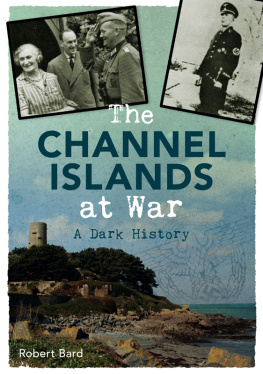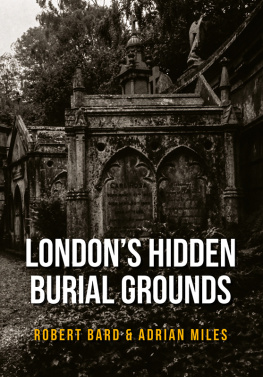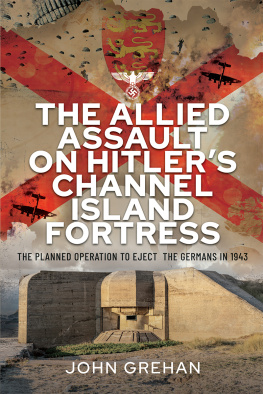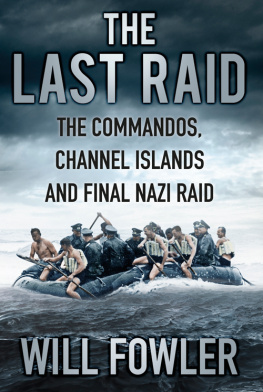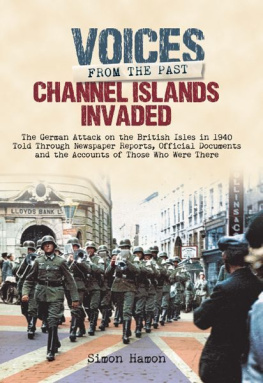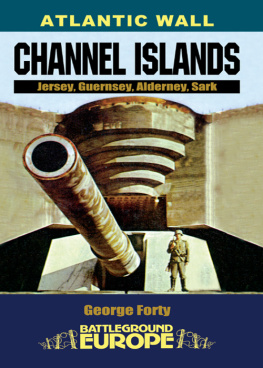The right of Robert Bard to be identified as the Author of this work has been asserted in accordance with the Copyrights, Designs and Patents Act 1988.
All rights reserved. No part of this book may be reprinted or reproduced or utilised in any form or by any electronic, mechanical or other means, now known or hereafter invented, including photocopying and recording, or in any information storage or retrieval system, without the permission in writing from the Publishers.
British Library Cataloguing in Publication Data.
A catalogue record for this book is available from the British Library.
Typesetting by Amberley Publishing.
Printed in the UK.
German fortifications litter the Guernsey shoreline.
Introduction
The Channel Islands were occupied on 30 June 1940, when four German planes landed at Guernsey Airport. They were the only part of Britain to be occupied during the Second World War. The islands had been officially demilitarised on 19 June, but the War Office in London overlooked the necessity to inform the Germans. This led to a German air attack on 28 June, which resulted in thirty-eight civilian deaths. Hitler was extremely proud of the conquest of the Channel Islands, and saw it as a stepping-stone to the full invasion of the rest of Britain. With this in mind, he decided that the occupants, being of equal racial worth, should be allowed what writer Madeleine Bunting terms a model occupation in her book The Model Occupation. The occupying forces were instructed to behave correctly. This would show the rest of Britain that there was nothing to be feared from life under the Third Reich. This was one of the few occupations where the troops felt that the wearing of side arms was not necessary. As Bunting says, the Channel Islands seemed like a holiday camp to the Germans. The propaganda factor for Hitler was tremendous, reflected in newsreels and radio broadcasts, and he issued a number of directives ordering the islands to be heavily fortified so that they would not be retaken. These fortifications remain today, mostly intact; a silent, haunting reminder of events that took place over seventy years ago. They still raise questions that divide opinion, and as yet cannot be fully answered. The German occupation opened rifts in the island communities: there were collaborators, those that simply stayed quiet, flowing with events, and those that endangered themselves to protect or feed starving slave labourers. The States governments, representatives of HM King George VI under their leaders, termed Bailiffs, behaved in a manner that can only be described as treasonous the Jersey government perhaps less so than its counterpart on Guernsey.
In 1940, Germany was at the peak of her military power. The desire to win over the people of Britain meant that the now occupied Channel Islands were on display as a model of occupation. The islands became a popular place for German soldiers to take their rest and recreation. Many local women, whose boyfriends and husbands were away fighting for Britain, took German soldiers as lovers and boyfriends. The island museums have numerous pictures showing island women socialising with German soldiers. The island governing elites mixed with Germans of equal social status and, in many cases, forged friendships that outlasted the war. In the heady days of 1940, the island governments believed it to be almost inconceivable that the German occupation would not be permanent. The Germans regarded the islanders as cousins and allowed the existing island governments to remain in place under the existing Bailiffs. What happened next has led to a bitterness and acrimony that will probably remain until the events of 19401945 are distant history. Academics and historians are still trying to unravel the events of those years. What was clear was that there was brazen collaboration, which often led to actions by the island governments acting in a manner that, according to British law, could only be described as treason. In correspondence to a German colleague, the Bailiff of Guernsey referred to the Allies as the enemy forces.
As a former pilot with Jersey European Airways and a keen yachtsman, I have had continuous contact with Alderney, Guernsey and Jersey for over thirty-five years. The islands have a rugged beauty, in many ways reminiscent of Devon and Cornwall. The most prominent features, though, are the German defences that conspicuously scar the coastlines. One is never far from either a gun emplacement or an occupation museum. More sinister are the so-called German Underground Hospitals, built at murderous cost to life, using mainly Russian slave labour, though paid local labour was also used. With row after row of dark, concrete corridors, steel doors and tall chimneys (or escape shafts), it has been convincingly argued that these structures were originally designed as gas chambers. Alderney was evacuated and the inhabitants sent to the other islands, with the exception of a few locals who remained. The SS then set up the first and only concentration camp on British soil. Alderney effectively became nothing more than a collection of SS and Organisation Todt prison camps. Organisation Todt undertook much of the Third Reich civil and military engineering projects during the war and was notorious for using slave labour. On Alderney in particular, well-documented atrocities took place against predominantly Russian and Jewish prisoners. Today, one can still find bunkers, tunnels, barbed wire, and ominous-looking mounds on Longis Common. There are a number of plaques that recall the wartime events on what has been called The Island of Dread. It would seem that a number of Dutch companies made use of, and profited from, the readily available slave labour.
Today, the seeming peace of the island, its capital St Anne and Braye Harbour hide the scars of appalling atrocities. Braye Harbour, the main entrance to Alderney, is a stern, Victorian-looking edifice with mooring buoys for visiting yachtsmen. It boasts the longest breakwater in Europe. I sometimes moor in the harbour to show sailing friends the beauty of the island and some of the chillingly disturbing occupation remains, which they would otherwise have no idea existed. A number of disturbing survivor accounts exist, which will be examined. One in particular, written by a Spanish camp survivor, describes the inhumane conditions that he and his comrades were subjected to by the SS, and provides a horrific account of the fortifying of the Braye area and Fort Albert in particular, which is now a peaceful tourist spot a few hundred yards from Braye Harbour. Many prisoners died, mainly Russian and Polish, and their bodies were thrown off the surrounding high points into the harbour. Divers were sent down to clear bodies to prevent the submarine boom from clogging up. Today, yachts bob gently around on mooring buoys. For me, the harbour for all its outward appearance of peace and tranquillity has a dark, brooding, haunted atmosphere.
Bunker St Ouens Bay, Jersey.
Over the years, in the course of research relating to the Channel Islands during the Second World War, it became clear to me that the islanders expected a German victory, and embraced their conquerors accordingly. It also became apparent that the only form of resistance to manifest itself on the islands occurred when it looked like Germany might not win the war. This scenario first became likely in October/November 1942, with the German defeat at El Alamein, followed by the total defeat and capture of Germanys 6th Army at Stalingrad in February/March 1943. Without any resistance, the States Parliaments, representatives of the British Government, implemented the German anti-Jewish racial policies. The remaining island Jews were rounded up, their property assessed, and they were shipped off to France, and subsequently to Auschwitz. There is evidence that British nationality managed to protect Jews who were deported in February 1943; instead of being separated, they were allowed to remain with other deported islanders. Intriguingly, after the end of the war, the island political leaders (who, it was later suggested, should have been tried for treason and hanged) were knighted for political reasons. Alexander Coutanche, the Bailiff of Jersey, who had not so blatantly served the Germans, was later given a life peerage. Others, whose behaviour could, at the very least, be said to be questionable, were also honoured. Much of the existing documentation regarding the Channel Islanders and their behaviour was put under a 100-year lockdown until 2045, but enough is available to follow clearly the course of events. We have a good idea of the sort of material the closed files contain due to copies appearing in the Moscow State Archives, and the Holocaust Research Centre, Yad Vashem, in Jerusalem. This could be regarded as a bland and oversimplified response to post-war accusations that there was no resistance. Balanced works tend to be lacking, as do works that place the occupation within the context of the other German occupations in nearby France, Holland, and Belgium. It has even been suggested by some islanders that the Channel Islands, in the context of resistance, were a unique case and should not be compared with mainland European resistance movements.

